

HomePage | Optical Illusions | War Stories | QBasic | Dads Navy Days | Bristol | Bristol, USA | Bristol, Canada | Terre Haute | Miscellany | Web Stuff | About Ray | Site Map | Site Search | Messages | Credits | Links | Web Rings
Bristol | Place Names | Legends, Pre-history and the Romans | Birth of the City | 1100 Onwards | Voyages | 1450 Onwards | 1650 Onwards | 1700 Onwards | Riots | The Blitz (Page 1), (Page 2) | The Castle (Page 1), (Page 2), (Page 3), (Page 4), (Page 5), (Page 6) | Blaise Castle (Page 1), (Page 2) | Castle Green (Page 1), (Page 2) | Union Street | Broadmead | The Old City (Page 1), (Page 2), (Page 3), (Page 4) | Christmas Steps (Page 1), (Page 2) | St. Mary Redcliffe (Page 1), (Page 2), (Page 3) | College Green (Page 1), (Page 2) | King Street (Page 1), (Page 2) | Clifton (Page 1), (Page 2) | Avon Gorge (Page 1), (Page 2), (Page 3) | Hotwells (Page 1), (Page 2) | City Docks (Page 1), (Page 2), (Page 3) | Bedminster (Page 1), (Page 2), (Page 3), (Page 4), (Page 5), (Page 6), (Page 7) | Old Market (Page 1), (Page 2) | St. George (Page 1), (Page 2) | Temple (Page 1), (Page 2), (Page 3) | Arno's Vale Cemetery (Page 1), (Page 2) | Brislington | @ Bristol | Oldest House | I. K. Brunel (Page 1), (Page 2) | Ma Pugsley | Yeamans | Boundaries (Page 1), (Page 2) | Photography | Exhibition (Page 1), (Page 2) | Lead Working | Historical Perspective | Virtute et Industrial | Other Sites | Bibliography (Page 1), (Page 2) | Help Wanted (Page 1), (Page 2), (Page 3)
Bristol - Bedminster 1
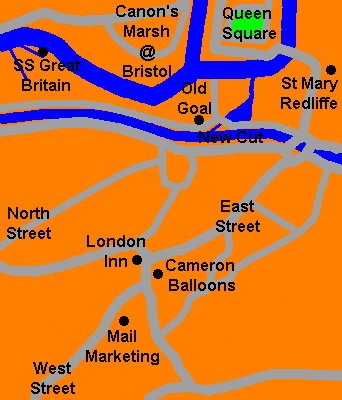
The northern edge of Bedminster is defined by the New Cut. It was dug between 1804 and 1809, when the Floating Harbour was built in the first decade of the 19th Century. Its purpose is to carry the river Avon around the harbour and it runs from Totterdown to Hotwells.
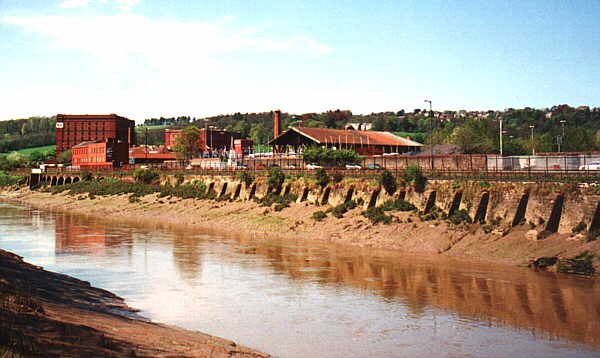
The New Cut - looking towards Hotwells and Cumberland Basin
The large brick building is the old Bond Warehouse where goods that were especially taxed by the Government such as spirits or tobacco were kept. There are several around the docks, most have gained a new lease of live as "posh" flats or artists studios. This one is used is still used as a warehouse.
A note to my trans-atlantic friends :-
"posh" means the same as "well heeled" and comes from the days of the grand cruises. It's an acronym meaning Port Out, Starboard Home, which referred to what was considered the best side of the ship to have a cabin when leaving and entering Southampton harbour.
A flat is the same as an apartment
Sorry if I'm teaching you to suck eggs but, like the word "fortnight" which means 'two weeks', whenever I use them I nearly always have to explain what they mean.
It looks like the explanation I gave for the word "posh" may be just wishful thinking. In February 2005, I received this email from Bryn...
From Word Origins...
Supposedly, this acronym was printed on first-class tickets issued by the Peninsular and Oriental Steam Navigation Company going from England to India. The port side on the trip out would have the coolest cabins (or alternately the cabins with the best view). The same would be true of the starboard cabins on the return trip. From this origin, sprang the usage of the term meaning swank, elegant, or fashionable. Unfortunately for this excellent story, no tickets with Posh stamped on them have been found and company records reveal no sign of the phrase.
There are several suggestions for the origin of posh. The best known derives it from an acronym associated with the Peninsular and Oriental Steamship Company. It supposedly stood for "Port Out, Starboard Home". The Company is said to have marked the tickets of higher status passengers with this so that they were put in cabins on the side of the ship that got the benefit of the cooling sea breezes on the outward and return journeys from Britain to India.
From World Wide Words...
Other suggestions, rather more probable, are that it is an abbreviated form of polished or polish (an example of what’s called grammatical syncopation, where a middle syllable has been left out), or that posh originally meant "halfpenny" (from the Romany posh "half") and then developed into "money" before acquiring its present meaning. Or it may come from the slang pot ("big", hence a person of some importance).
Oh well, another nice story debunked. Anyway, on with the story of Bedminster...
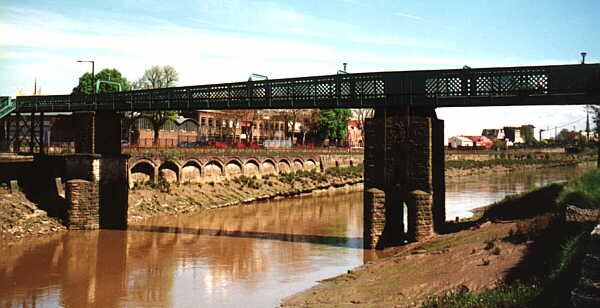
The New Cut looking towards the city
It is believed by some that French prisoners-of-war from the Napoleonic wars helped dig this channel. Other people say that this was not true and it was dug entirely by navvies. I've certainly not come across any references to French prisoners-of-war building it. One interesting item I did find about it is that while they were digging it they found a large number of trees buried about 20 feet down in the clay. The trees were "lying mostly in one direction and it appeared as though they had been swept down suddenly by a hurricane." It is thought that the trees were blown down in the Great Storm of 1703.
Further along the Cut, nearer to St Mary Redcliffe can be seen the Old gaol.
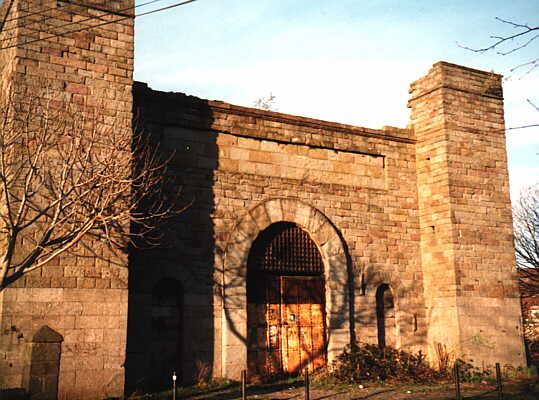
The Old gaol on the New Cut
The first public execution here was on 13th April 1821. Eighteen year old John Horwood threw a stone at his would be girlfriend, Eliza Balsum. She died of her injuries and he was hung here for it. Horwood had been making advances towards the girl for some time, all of which she rejected. On one occasion he threw vitriol (concentrated sulphuric acid) over her. Captured after a violent struggle Horwood was taken to the dying girl's bedside where he appeared unrepentant as the deposition was read to him. In jail, Horwood said, "Lord, thou knowest that I did not mean then to take away her life but merely to punish her: though I confess that I made up my mind, some time or other, to murder her." Horwood was hung using the "short drop" method, which is basically slow strangulation, instead of "long drop" which results in instant death by breaking the neck.
Thomas Hasell who lived in Bedminster, was a City Councillor and went on to become Sheriff three times and was Mayor from 1824 - 1825, gave Horwood's body to the surgeon, Richard Smith, for dissection. Smith had the boy's skin tanned and with which he bound a book containing all the records of the murder, trial and execution. This must have been a bit of a conversation stopper as a "coffee table" book. Actually, the book which was bound in his skin was held at the Bristol Infirmary but is now held at the Bristol Records Office. Two other books which were bound with the remainder of his skin are held at the Bristol Law Society's library. The books have the inscription "Cutis Vera Johannis Horwood" ("The Skin of John Horwood") in gilded letters on the covers. (Many thanks to Lisa Campling for correcting me when I originally gave the name of Thomas Howard for the hung boy and for giving the location of those books.)
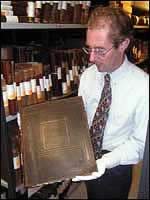
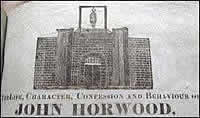
These images of the book come from "Today in Odd History"
During the Reform Riots of 1831, this was stormed by a large number of rioters, the prisoners released, the gallows and treadmill were wrecked, thrown into the river and the building set on fire. As punishment for their part in the riot four of the rioters were hung from this entrance. The jail was rebuilt, but was closed for good in 1887 following the Prison Reform Act. On Sunday, 7th May 2000, a plaque was unveiled to commemorate the people who were hung from this gateway or transported for their part in the riots.
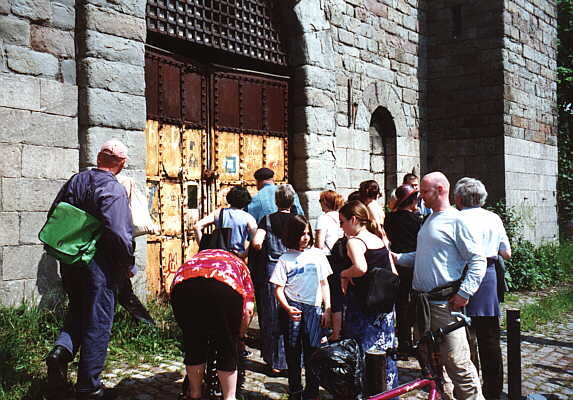
The plaque on the Old gaol
Bedminster is older than Bristol proper and got its name from the monastery or church founded by the monk Beda. Another source gives the origin of the name as the old British word "bedydd" which means baptism. The Malago is part of Bedminster and this may have got its name from "melis" (mill) and "agos" (place). It became a part of Bristol, rather than a seperate town in 1831.
East and West Streets, two of the main streets through Bedminster, follow old Roman roads. Just to the south of East Street lie what is left of St John's Church. The foundations of this church may be older than any other in Bristol. In the 12th century it became the mother church of the churches of St Mary Redcliffe and Abbot's Leigh, and the chapels of Bishopsworth and Knowle. Henry Chichele, who became Archbishop of Canterbury, started his career here. Not so lucky was the vicar Edward Powell who was hanged at Tyburn in 1536 for refusing to take the Oath of Supremacy to Henry VIII. St Mary Redcliffe and St Thomas the Martyr became separate parishes in 1852. St. John's has been rebuilt many times, the last was in 1855 by the Reverend Henry George Eland, who was vicar from 1852 to 1883, to a design by John Norton who was the architect for Stoke Bishop, Emmanuel and St Luke's Churches. The rebuilding was finished in 1854 but the consecration was delayed until 30th October 1855 due to an argument over some of the carvings in the church which were considered "too popish" for the Anglicans.
One particularly charismatic vicar was the Reverend John Baghot de la Bere. who was vicar from 1902 to 1919. One story about him is that one day he visited an old parishoner who was suffering from rheumatism, Baghot gave him a bottle of Hospital Bovril (a drink made from beef extract). A few days later Baghot revisited the parishoner who told him that he felt much better after rubbing the whole lot in! In 1917 became chaplain to HM Forces in France and later in Egypt and India. The church was blitzed on 11th April 1941, and finally demolished in 1967. The old churchyard still remains as a small park tucked away between the houses and factories. The only other lasting monuments to this church are the names of the roads surrounding the park, Church Road, St. John's Street and St. John's Road.
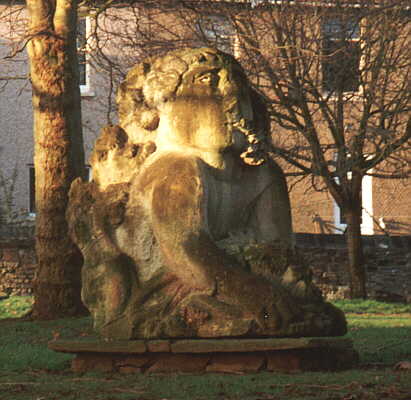
Sculpture in St John's Churchyard park
The Manor of Bedminster once encompassed all the land south of the River Avon from the Gorge in the west to Brislington in the east. It was owned by several families when around 1130 it came to be in the hands of Robert Fitzharding. This is the same man who founded what became the cathedral in 1140. In 1154 he became the Baron on Berkeley, and founded the Manor of Berkeley to the north of Bristol, but the family seemed to prefer being in Bedminster. In 1200 Robert Fitzharding, by now he was also known as Robert de Berkeley, built St. Catherine's Hospital between Bedminster and Redcliffe. The hospital provided food and and lodgings for pilgrims travelling to Glastonbury. It was demolished in 1880 but the name is remembered in Catherine Mead Street and the name of a shopping arcade, St. Catherine's Place. The hospital also had a windmill, and it was this that gave the nearby district of Windmill Hill its name. It was demolished in 1820.
The power of the Fitzhardings waned and after 1416 the land passed through the female line. In the 15th century this is the district that lepers were exciled to from Bristol. A leper hospital, St Mary Magdalene's, used to stand between Brightbow and Redcliffe. It was closed around 1572, became a glassworks, then a tannery and finally demolished in the 1880's to make room for the Will's factory. In 1605 the Manor of Bedminster was purchased by the Smyths of Ashton Court.
Brightbow was a small area that is mentioned a lot in histories of Bedminster. It used to cover the area that is now Bedminster Parade, which itself is at the Redcliffe end of East Street.
Bedminster had flourished up to this time and was on a par with other market towns such as Glastonbury and Frome further south in Somerset. In 1644, during the Civil War, Bedminster was sacked and burnt by Prince Rupert, it never fully recovered, and by the middle of the 18th century, when John Wesley preached here, was very much decayed.
There is now very little remaining evidence, but Bristol sits on extensive coal deposits, and it was these that bought a new prosperity to the district. Small scale open-cast mining was reported as taking place as long ago as the 1670's but in 1744 Jarrit Smyth called in Henry Bennett, a mining surveyor from Kingswood, and the first shafts were sunk in South Liberty Lane. The Smyths made a whole bunch of money and Bedminster, with easy access to the docks and the demand for coal increasing, prospered. By the 1820's there were over a dozen coal-pits in the Bedminster area. These were scattered throughout the area, with the Old Engine, Great Engine, Ashton Vale and South Liberty Lane pits at Bedminster Down and Ashton Vale. At the other end of Bedminster was the Argus pit. Dean Lane pit is where the Dame Emily playground is now, the bandstand covers the old pit shaft. It was the largest of the pits, employing 400 men and with a main shaft of over 1,000 feet. West Street pit, also known as the Red Cow or Malago pit was situated where the old Colodense building, now Mail Marketing International, where I work, is now. In 1840 the Senior Churchwarden of St John's Church was William Goulstone, he also owned Bedminster North Side Colliery. You'd never know it now but East Street was once lined with the slag heaps from these colleries. Between 1850 and 1880 just under half the local male population were employed by the colleries.
By the 1880's the smaller colleries had either gone out of business or had been amalgamated into one of the four remaining ones. Accidents were common in these colleries. At Dean Lane pit, which closed in 1906, nine people were killed in 1886 and ten at the Argus pit in 1891. The South Liberty Lane pit was the longest running. It was the first to open in 1744 and the last to close in 1925. Its coal came from the four feet thick Bedminster Great Vein, the pit was 800 feet deep and the tunneling stretched from Dundry to Temple Meads, a distance of around 5 miles. One of the roughest and toughest of men from this pit was Joe Wring.
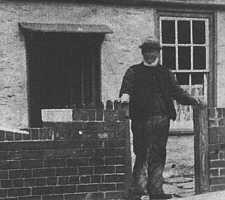
Joe Wring ~ 1910
He had a shovel especially made so that he could heave a hundredweight (112lbs) of coal at a time. He once won a £5 bet by lifting a 14 stone (196 lbs) man, Colin Marshall, into a coal truck. Other miners were equally tough and some would try winning 5 shilling bets by trundling a wheelbarrow full of bricks to Weston-Super-Mare and back, a total distance of about 20 miles.
Bristol | Place Names | Legends, Pre-history and the Romans | Birth of the City | 1100 Onwards | Voyages | 1450 Onwards | 1650 Onwards | 1700 Onwards | Riots | The Blitz (Page 1), (Page 2) | The Castle (Page 1), (Page 2), (Page 3), (Page 4), (Page 5), (Page 6) | Blaise Castle (Page 1), (Page 2) | Castle Green (Page 1), (Page 2) | Union Street | Broadmead | The Old City (Page 1), (Page 2), (Page 3), (Page 4) | Christmas Steps (Page 1), (Page 2) | St. Mary Redcliffe (Page 1), (Page 2), (Page 3) | College Green (Page 1), (Page 2) | King Street (Page 1), (Page 2) | Clifton (Page 1), (Page 2) | Avon Gorge (Page 1), (Page 2), (Page 3) | Hotwells (Page 1), (Page 2) | City Docks (Page 1), (Page 2), (Page 3) | Bedminster (Page 1), (Page 2), (Page 3), (Page 4), (Page 5), (Page 6), (Page 7) | Old Market (Page 1), (Page 2) | St. George (Page 1), (Page 2) | Temple (Page 1), (Page 2), (Page 3) | Arno's Vale Cemetery (Page 1), (Page 2) | Brislington | @ Bristol | Oldest House | I. K. Brunel (Page 1), (Page 2) | Ma Pugsley | Yeamans | Boundaries (Page 1), (Page 2) | Photography | Exhibition (Page 1), (Page 2) | Lead Working | Historical Perspective | Virtute et Industrial | Other Sites | Bibliography (Page 1), (Page 2) | Help Wanted (Page 1), (Page 2), (Page 3)
HomePage | Optical Illusions | War Stories | QBasic | Dads Navy Days | Bristol | Bristol, USA | Bristol, Canada | Terre Haute | Miscellany | Web Stuff | About Ray | Site Map | Site Search | Messages | Credits | Links | Web Rings
This page created 5th August 2000, last modified 11th December 2005